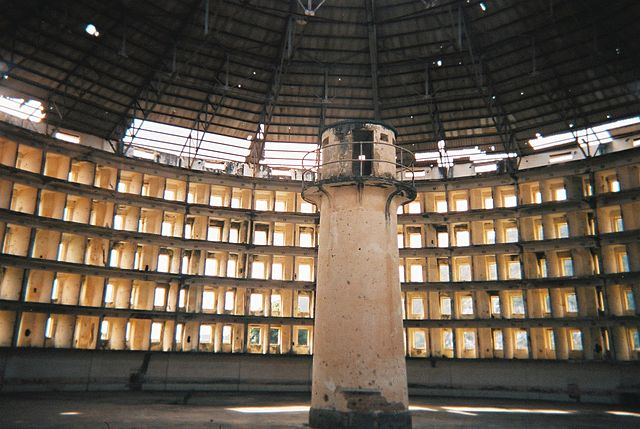Discipline has been defined in a variety of seemingly contrasting ways.
For example, discipline “is a repressive operation by which individuals are seasoned into productive labor” (Foucault, 1977). Moreover, it’s “a policy of coercions that act upon the body, a calculated manipulation of its elements, its gestures, its behavior…thus discipline produces subjected and practiced bodies, ‘docile’ bodies” (Foucault, 1977).
 “Presidio-modelo2” by I, Friman. Licensed under CC BY-SA 3.0 via Commons – https://commons.wikimedia.org/wiki/File:Presidio-modelo2.JPG#/media/File:Presidio-modelo2.JPG
“Presidio-modelo2” by I, Friman. Licensed under CC BY-SA 3.0 via Commons – https://commons.wikimedia.org/wiki/File:Presidio-modelo2.JPG#/media/File:Presidio-modelo2.JPG
A more pragmatic definition suggests that regardless of ideology, “most schools implement student discipline through a crime control lens” (Hirschfield, 2008).
Per this author, the process of discipline tends not to reflect in theoretical discussions of discipline, “most theoretical explanations fail to situate school criminalization in a broader structural context, to fully explain its spatio-temporal variations, and to specify the processes and subjectivities that mediate between structural and legal forces and the behavior of school actors.”
Others define discipline as separate from punishment and externally imposed controls. They see discipline as a “necessary condition for effective action in the social world” (Freire, 1998). They want to nurture self-discipline in students (Noguera, 1995). They suggest that “true discipline does not exist in the muteness of those who have been silenced but in the stirrings of those who have been challenged, in the doubt of those who have been prodded, and in the hopes of those who have been awakened” (Freire, 1998). Other scholars suggest that this embodiment of discipline requires” rigorous mental or physical training through which we may construct new subjectivities and emancipatory practices” (Foucault, 1977).
 “1590-MT-au-Peru-2011-Consciousness-Based-Education” by Jdontfight – Own work. Licensed under CC BY-SA 3.0 via Commons – https://commons.wikimedia.org/wiki/File:1590-MT-au-Peru-2011-Consciousness-Based-Education.JPG#/media/File:1590-MT-au-Peru-2011-Consciousness-Based-Education.JPG
“1590-MT-au-Peru-2011-Consciousness-Based-Education” by Jdontfight – Own work. Licensed under CC BY-SA 3.0 via Commons – https://commons.wikimedia.org/wiki/File:1590-MT-au-Peru-2011-Consciousness-Based-Education.JPG#/media/File:1590-MT-au-Peru-2011-Consciousness-Based-Education.JPG
So which definition do you subscribe to or use in your classroom or home? How might social, political, and economic power influence definitions and implementations of discipline?
You might find that you employ multiple definitions at different times. That is, discipline is a concept that seems to embody at least three stages: 1.) a practice of controlling behavior either internally or externally towards some ends; 2.) detection or recognition of behaviors that require further control for correction; and 3.) responses to noted instances of discipline to correct for behavior. Which of the presented definitions relate with each step? Are there other steps associated with discipline that I haven’t included here?
As we continue to discuss components of restorative practices in this series of blog posts, it will be important to clarify how each component relates with different parts of discipline such that we can understand how we might avoid using restorative practices in ways consistent with a “ repressive operation by which individuals are seasoned into productive labor” (Foucault, 1977).
References
- Foucault, M. (1977). Discipline and punish: The birth of the prison. Vintage.
- Freire, P. (1998). Pedagogy of freedom: Ethics, democracy, and civic courage. Rowman & Littlefield.
- Hirschfield, P. J. (2008). Preparing for prison?: The criminalization of school discipline in the USA. Theoretical Criminology, 12(1), 79–101. http://doi.org/10.1177/1362480607085795
- Noguera, P. A. (1995). Preventing and producing violence: A critical analysis of responses to school violence. Harvard Educational Review, 65(2), 189–213.








